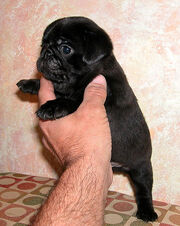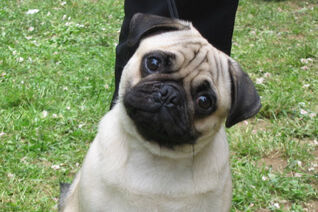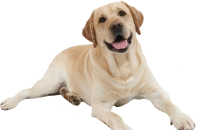No edit summary |
No edit summary |
||
| Line 1: | Line 1: | ||
[[File:A_black_pug_puppy_-_puglet.jpg|thumb|A black puglet |
[[File:A_black_pug_puppy_-_puglet.jpg|thumb|A black puglet |
||
]][[File:Gadget_the_pug_expressive_eyes.jpg|thumb|A pug with expressive eyes]][[File:Pug.jpg|thumb|318px|right|A pug]] |
]][[File:Gadget_the_pug_expressive_eyes.jpg|thumb|A pug with expressive eyes]][[File:Pug.jpg|thumb|318px|right|A pug]] |
||
| − | The '''pug''' is a " |
+ | The '''pug''' is a "toy " (very small) breed of dog with a wrinkly, short-muzzled face, [[File:DOGS 101 - Pug ENG|thumb|right|335 px]]and curled tail. Pugs are not named after the word pugleton.The breed has a fine, glossy coat that comes in a variety of colors, and a compact square body with well-developed muscle. They have been described as ''multum in parvo'' ("much in little"), referring to the pug's personality and small size.Known in ancient China as ''lo-sze'', they may have been responsible for both the modern Pekinese and King Charles spaniel. They have Chinese origins, but were popularised in Western Europe by the House of Orange of the Netherlands and the House of Stuart of England, Ireland and Scotland. |
| − | They can suffer from a variety of health issues, including |
+ | They can suffer from a variety of health issues, including overheating, obesity, pharyngeal reflexand two fatal conditions which are necrotizing meningoencephalitis and hemivertebrae. In addition, care must be taken by their owner to clean their ears, and the folds of skin on their face. |
==Description== |
==Description== |
||
| − | The breed is often summarized as ''multum in parvo'' ("much in little"), describing the pug's remarkable personality despite its small size.While the pugs appearing in eighteenth century prints tended to be long and lean, modern breed preferences are for a square, |
+ | The breed is often summarized as ''multum in parvo'' ("much in little"), describing the pug's remarkable personality despite its small size.While the pugs appearing in eighteenth century prints tended to be long and lean, modern breed preferences are for a square, cobby body, a compact form, a deep chest, and well-developed muscle. Pugs have two distinct shapes for their ears, "rose" and "button". "Rose" ears are smaller than the standard style "button" and are folded with the front edge against the side of the head. Breeding preference goes to "button" style pugs. The legs are very strong, straight, of moderate length, and are set well under. The shoulders are moderately laid back. The pasterns are strong, neither steep nor down. The feet are neither so long as the foot of the hare, nor so round as that of the cat; well split-up toes, and the nails black. The lower teeth normally protrude further than their upper, meeting in an under-bite |
====Coat and color==== |
====Coat and color==== |
||
| − | Their smooth, glossy coats can be fawn, apricot, silver or black. There is also the rarer white pug which gets its coat via breeding or |
+ | Their smooth, glossy coats can be fawn, apricot, silver or black. There is also the rarer white pug which gets its coat via breeding or albinism. A silver coat is characterized by a very light coloured coat, absent of black guard hairs. A silver pug typically has a very dark head, with no clear delineation at the mask, and dark forelegs. The markings are clearly defined. The trace is a black line extending from the occiput to the tail. The tail normally curls tightly over the hip. |
Revision as of 17:31, 20 April 2014

A black puglet

A pug with expressive eyes

A pug
The pug is a "toy " (very small) breed of dog with a wrinkly, short-muzzled face,

DOGS 101 - Pug ENG
and curled tail. Pugs are not named after the word pugleton.The breed has a fine, glossy coat that comes in a variety of colors, and a compact square body with well-developed muscle. They have been described as multum in parvo ("much in little"), referring to the pug's personality and small size.Known in ancient China as lo-sze, they may have been responsible for both the modern Pekinese and King Charles spaniel. They have Chinese origins, but were popularised in Western Europe by the House of Orange of the Netherlands and the House of Stuart of England, Ireland and Scotland.
They can suffer from a variety of health issues, including overheating, obesity, pharyngeal reflexand two fatal conditions which are necrotizing meningoencephalitis and hemivertebrae. In addition, care must be taken by their owner to clean their ears, and the folds of skin on their face.
Description
The breed is often summarized as multum in parvo ("much in little"), describing the pug's remarkable personality despite its small size.While the pugs appearing in eighteenth century prints tended to be long and lean, modern breed preferences are for a square, cobby body, a compact form, a deep chest, and well-developed muscle. Pugs have two distinct shapes for their ears, "rose" and "button". "Rose" ears are smaller than the standard style "button" and are folded with the front edge against the side of the head. Breeding preference goes to "button" style pugs. The legs are very strong, straight, of moderate length, and are set well under. The shoulders are moderately laid back. The pasterns are strong, neither steep nor down. The feet are neither so long as the foot of the hare, nor so round as that of the cat; well split-up toes, and the nails black. The lower teeth normally protrude further than their upper, meeting in an under-bite
Coat and color
Their smooth, glossy coats can be fawn, apricot, silver or black. There is also the rarer white pug which gets its coat via breeding or albinism. A silver coat is characterized by a very light coloured coat, absent of black guard hairs. A silver pug typically has a very dark head, with no clear delineation at the mask, and dark forelegs. The markings are clearly defined. The trace is a black line extending from the occiput to the tail. The tail normally curls tightly over the hip.
Temperament

A purebred white pug
Strong willed but rarely aggressive, the pug is suitable for families with children. The majority of the breed is very fond of children and sturdy enough to properly play with them. They can be quiet and docile but also vivacious and teasing depending on their owner's mood. They can make good watchdogs, they are always alert and sometimes yappy.
